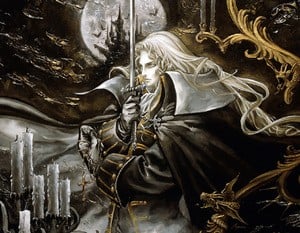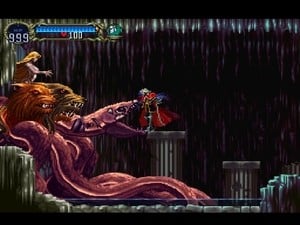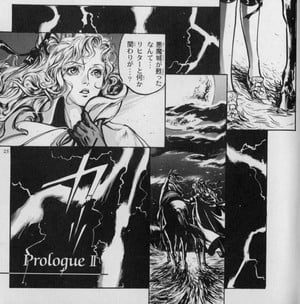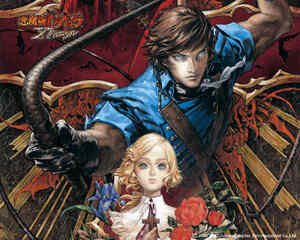
Castlevania: Symphony of the Night marked a major turning point for the Castlevania series. With the exception of the free-roaming Simon’s Quest on the NES, over a decade’s worth of instalments had displayed an unwavering commitment to the fairly straightforward ‘platform action’ template, which saw the player utilising the legendary Vampire Killer whip to send all manner of nocturnal beasties packing.
Contrary to popular belief, Koji ‘IGA’ Igarashi was not employed as Primary Director on the project – that honour fell to Toru Hagihara, who was also responsible for the excellent Dracula X: Rondo of Blood on NEC’s PC Engine Super CD-ROM system. IGA - who would go on to become the overall producer of the entire franchise - served as Assistant Director as well as participating in the writing of the scenario and general programming, so it could be argued that he had the most telling influence over the creation of the game.
It was apparent from the outset that Konami wished to steer the franchise in a fresh, new direction. “Action games could be cleared in a short time, but I wished to create a game which could be enjoyed for a long time” explains IGA. Taking inspiration from Nintendo’s SNES classic Super Metroid, the team decided to shy away from the ‘stage by stage’ concept of previous titles and cultivate a totally open, free-roaming castle to explore. The player was denied access every portion of Vlad’s sprawling, demonic fortress from the outset but a finely-tuned drip feed of abilities, ranging from the humble double-jump to unique vampire shape-changing enchantments, would gradually open up more and more of the aging citadel as progression was made. This resulted in a game that rewarded exploration and proved to be a supremely involving and enjoyable experience, whilst thankfully retaining the classic ‘hack and slash’ action that aficionados of the series held so dear.

Another major alteration was the introduction of ‘Role Playing’ mechanics. This particular evolution was borne out of the common perception that the series was a something of a tough nut in terms of challenge, as IGA explains: “I wanted to change the impression that Castlevania was a difficult action game. When we decided to adopt RPG elements, we agreed that users would deserve something good when beating enemies. So, I thought of Experience Points.”
For the first time in the series, players could enhance their chance of victory by ‘levelling up’ and augmenting their character with a vast array of powerful weapons, armour and spells. The concept of earning experience for every enemy successfully slain also prevented the inevitable back-tracking from becoming too arduous, and in many ways made the game more accessible for less skilled gamers. “I thought that even the users who were not good at playing action games would be able to clear the game if I adopted the system,” reveals IGA. The introduction of a multitude of useful items - including healing potions, food and ‘one shot’ weaponry - imbued SotN with a degree of depth that had never been experienced before in such a title.
Not content with shaking things up gameplay-wise, IGA also turned a few heads when it came to selecting the major character for the game. Traditionally, the vampire-hunting Belmont clan took centre stage in Castlevania titles, but SotN saw the player controlling the half vampire, half human offspring of Dracula himself - Alucard. “I chose a character that had a special link to the previous Castlevania titles,” comments IGA. Alucard had previously appeared in Castlevania III: Dracula’s Curse on the NES (which IGA cites as his favourite entry in the entire series), where he fought alongside Trevor Belmont to prevent his patriarch’s murderous revival.
Traditionally, the vampire-hunting Belmont clan took centre stage in Castlevania titles, but SotN saw the player controlling the half vampire, half human offspring of Dracula himself - Alucard
Resurrecting the ‘Tragic Prince’ proved to be an inspired move, but IGA reveals that at the time he was concerned that such a decision would anger the fans. “Personally, I liked Alucard very much and it was totally fine with me, but I presumed that those who had been fans for a long time would be angry since it was the first time for the series to have a non-whip using character as a hero.” He needn’t have worried. “The Japanese title was “Akumajo Dracula X”. I used “X” to show that it would be apart from the main stream of the series. But, surprisingly, it has become the mainstream,” he comments with a degree of satisfaction. Alucard is now regarded as one of the most popular characters in the Castlevania universe and IGA is well aware of the impact he had on the triumph of SotN. “Alucard was very cool, and that is why Symphony of the Night has been received so favourably.”
The Castlevania franchise has always had a reputation for high quality musical accompaniment and SotN is no exception. Indeed, many consider Michiru Yamane’s work to be the finest ever heard in a Castlevania title. With this in mind, did IGA ever feel the expectation of aural excellence imposed limitations on his development? “The music direction has never led the creation of the game. I have always asked Michiru to compose music in accordance with the game. She always coordinated with the development team and composed music from the image of the stages.” When asked which tune was his favourite, IGA playfully admits that he’s slightly biased: “My favourite is “Castle Dracula” which starts to play when Alucard enters the castle for the first time. I am impressed that the music starts to play once Alucard enters the dark castle and then suddenly the castle gets bright and Zombies appear. It might be because that part was programmed by myself!”
Yamane’s soundtrack was a fusion of rock, jazz and classical styles that appeared hopelessly mismatched on paper but worked surprisingly well in practice. The musical package was rounded off rather neatly by Rika Muranaka’s heart-wrenching ‘I am the Wind’ (sung by American artist Cynthia Harrell, who also provided the vocals for the infamously camp title theme of Metal Gear Solid 3: Snake Eater) which plays over the end credits.

The introduction of Ayami Kojima's sumptuous artwork was the icing on an already tantalisingly gorgeous cake. Again, a desire to establish a new vision for the series was the main reason behind her involvement, as IGA explains: “The world of vampire I have in my mind is beautiful and fleeting with blood and darkness. The series had a visual image featuring hostility, but I tried to change the image since the game concept itself was going to change.” Kojima’s mature and astonishingly detailed art elevated the game to a whole new level of brilliance. Her combination of Japanese sensibility with classical painting methods resulted in some of the most breathtakingly stunning artwork ever attributed to a videogame release, and it’s a testament to her truly wonderful talent that when a new Castlevania title is announced you can bet that one of the first questions to flash across internet forums worldwide is “Has Kojima done the artwork?”
With this amalgamation of fantastic gameplay, stupefying depth, gorgeous design and a downright brilliant musical score, it’s unsurprising that SotN went on to sell thousands in Japan (where it was released under the title ‘Akumajo Dracula X: Gekka no Yasoukyoku’, which translates as ‘Demon Castle Dracula X: Nocturne in the Moonlight’). Huge sales and heaps of critical acclaim were also prevalent when the game debuted in the US but it perplexingly failed to replicate this success in Europe.
Reports vary, but it is believed that the initial print run for the PAL version was around the 15,000 mark and many of these copies had to be heavily discounted by disappointed retailers before they eventually sold. It’s been argued that lukewarm reviews in the UK press contributed to the dour performance at retail, but whatever the cause Konami knew they had a turkey on their hands and consequently didn’t produce any more PAL copies, whereas in Japan and the US the game was reprinted several times in order to satisfy demand and was eventually granted ‘Greatest Hits’ status in both territories. The low number of PAL units, coupled with the fact that the majority came with highly desirable limited edition items such as an artwork book and music CD has recently caused prices to sour – it’s not unusual for a mint and complete Euro edition of the game to fetch three figure sums on eBay, whereas the NTSC versions sell for much, much less.

Since the launch of SotN, Konami has released similar titles for the Game Boy Advance and Nintendo DS, most of which were crafted under the watchful eye of IGA. However, more recently the best-selling series has taken a change of direction with the Euro-produced Lords of Shadow sub-series; although figures haven't been officially confirmed, the first LoS title is apparently the most commercially successful in the entire history of the franchise.
With Lords of Shadow 2 looming on the horizon, one might assume that it's time to put past glories such as SotN to bed - however, a quick blast on the emulated version bundled in the PSP release Castlevania: The Dracula X Chronicles should be enough to prove that regardless of where Konami takes the lineage, SotN arguably remains its most glorious moment.
This feature was originally printed in its entirety in Retro Gamer magazine, and is reproduced here with kind permission.
Comments 16
Awesome, awesome article!
Awesome Damo! I only got to play this for the first time a couple of years ago, nice to get some insight into it
I played alil of SotN and it is an awesome game. Wish I had it still
This game is Truly one of the most epic moments of my gaming life. Great read!
I just bought this game 2 weeks ago and I gotta say, it's one of my all time favorite Castlevania games. Leveling up a character has never felt so good before. hahaha
I always wanted to buy this. But even poorly preserved copies are quite expensive.
I first played this game when I was 7 or 8. And needless to say Castlevania SOTN is one of my favorite games of all time.
@Omega If you really want to get this game, you can get it in the PSN store or Xbox Live Arcade for $10.
a remake for vita would be perfect
PSN Store (Vita EU) doesnt list any single Castlevania
@DraculaX: It always pays to do a little internet research before making such claims of foreign digital shops. The European PSN does NOT have Symphony of the Night available for purchase. My research shows that they CAN get it on XBLA, however. So you have to shudder play it on Xbox 360 if you want it in Europe, pretty much.
I guess it sold so poorly at original release, they don't even think it'd do well on PSN now. That really sucks. Can't even get Castlevania X Chronicles...I had no idea it was so hard to be a Castlevania fan in Europe!
@Stuffgamer1: I made an American account and bought a couple of PSN cards from American users on Ebay, JUST so I could play this game!
XBLA indicates it is HD. Is that it is upscaled and smoothered or just upscaled and pixelated? (just in case some of you have it for 360)
@Stuffgamer1 glad I'm Canadian than, sounds like Europe got screwed on that one.
@DraculaX: I don't have an XBox360 or PS3. I have a PS2. So I can only consider the original PS1 game.
@ChunkyDroid: Yeah, that works too. Do what you gotta do, I guess.
@Mandoble: IIRC, there's a menu option so you can have it either way. Been years since I played it on XBLA though, so you probably shouldn't take that as 100% fact.
@Omega: If the prices are really so bad for a PS1 copy, you might just be better off getting an HD system to do the downloading. Besides which...it's kinda late in the console generation to still be without either, especially for someone still following a gaming news site like this.
@Stuffgamer1 : I don't want to follow the hype of new gaming systems. And I have enough old systems to keep me entertained for the next 1000 years. I only follow this gaming-news-site because I'm still interested in Virtual Console and WiiWare games. (Coming over from NintendoLife which originally was VC Reviews.)
Show Comments
Leave A Comment
Hold on there, you need to login to post a comment...